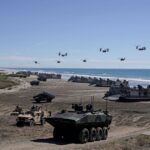
“An army marches on its stomach,” Napoleon is often quoted as saying.
The actual sentence was “an Army, like a serpent, goes upon its belly,” and it was spoken by Frederick the Great, but let’s not get caught up in details. The point is, if you want to win the battle, logistics is at least as important as tactics.
And had Frederick not died in 1786, when horse-mounted cavalry ruled the battlefield, he might have rethought that phrase. Petroleum products — gasoline, diesel and aviation fuel, lubricants — are what fuel the modern military.
Or they did until the advent of the latest main battle tank from General Dynamics Land Systems, anyway, which announced last week that it would be exhibiting its new “AbramsX technology demonstrator” during the Army’s Annual Meeting & Exposition in Washington, D.C., this week.
Described in the company’s news release as the “main battle tank for the next generation,” GDLS says the newest Abrams version will weigh significantly less than those currently in service, which could make the tank both more mobile and more easily transported to far-off battlefields.
The tank’s “hybrid power pack” will also consume half the fuel that current versions do and run more quietly; it “even allows for some silent mobility,” according to the company.
There’s only so silent a multi-ton vehicle is ever going to be when it’s on the move, of course, but things are relative on the battlefield.
This may be making a virtue of necessity, as the U.S. military — like every branch of an out-of-control federal government run by un-elected bureaucrats and increasingly left-leaning idealogues — has climate-change-related goals it must meet.
“The AbramsX’s hybrid power pack supports the U.S. Army’s climate and electrification strategies,” the company announced.
Is this a good direction for American armor?
Yes: 14% (1 Votes)
No: 86% (6 Votes)
Which isn’t necessarily a bad thing, obviously — so long as the platform’s lethality isn’t negatively impacted by the changes. The company’s release didn’t go into specifics about that; in its defense, it’s probably too early in the tank’s development even to know for sure. You never really know how a weapon is going to serve you until it’s been fired in anger.
And for that matter, GDLS is unlikely to share details about how less-dangerous its new tank is (if at all) on its own media page.
The company posted a short video of what it called its “technology demonstrator” on YouTube.
[embedded content]
Cool? Sure. Fuel-efficient? I guess so. Deadly? I have no idea. And that’s my concern.
Speaking as a special operations veteran, I can say with confidence that the only thing I care about in a weapons system — whether I’m the one employing it or it’s being used by my fellow service members or allies — is how well it rains down hell on the enemy.
At the end of the battle, I want to go home to my family having successfully completed my mission. I want everyone on my side to do the same thing. Of course, that’s not going to happen for every warfighter every time, but any other goal the military sets must be secondary. Nothing else even comes close.
Any amount of compromise on lethality in the name of a liberal agenda — or a conservative one, for that matter — is completely unacceptable.
There is a decided tactical advantage in mobility, reduced noise and fuel efficiency. Run farther, run faster, run quieter — those are all great.
Just so long as, when you’re done running, you can kill whatever it is you were running toward.







